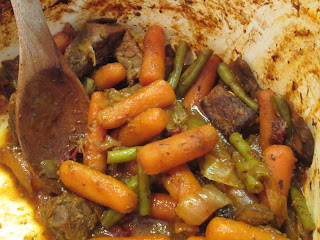Here's this week's recipe for beef stew.
1/2 to a whole onion chopped up
Baby carrots (what ever amount you want)
Green beans with ends removed (what ever amount you want)
Mushrooms (handful or whatever)
1 can tomato sauce
1-2 lbs. grass-fed beef (I like london broil for this)
- Put all the veggies in the dutch oven
- Season with basil, oregano, herbs de provence, salt and pepper.
- Add the tomato sauce
- Cut meat into little cubes.
- Sear the meat in a cast iron with oil until browned. (Work in batches, don't crowd the skillet).
- Add cooked meat to dutch oven.
- Add water (or wine) to the cast iron to get brown bits up and add to dutch oven.
- Cook at 325 for about an hour and a half
I always cook some sweet potatoes in the cast iron skillet while I'm waiting for the stew to finish. Then I throw them on as a last minute topper. You can add them in with the stew, but they tend to liquify in a stew, and i like the texture of the crunchy fried potato on top.
Enjoy!














